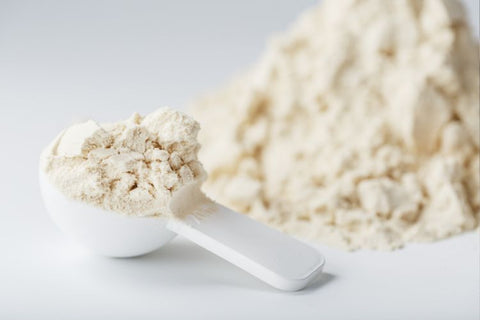The combination of casein and whey protein offers a dynamic solution to this query, providing a range of potential benefits beyond what each protein source offers individually. In this article, we delve into the potential benefits of combining casein and whey protein, exploring how their unique characteristics complement each other. From enhanced muscle protein synthesis to improved flavor and texture, we'll examine how this blend can contribute to a well-rounded approach to nutrition and fitness.
Complementary Amino Acid Profiles
Casein and whey protein are both high-quality proteins found in milk, but they differ in origin, digestion rate, and amino acid profile. Here's a breakdown:
Source and Digestion:
- Casein: Makes up about 80% of milk protein. It's a slow-digesting protein that forms a gel-like substance in the stomach, causing a gradual release of amino acids over time.
- Whey: A byproduct of cheese production, whey protein makes up about 20% of milk protein. It's a fast-digesting protein, quickly absorbed by the body.
Amino Acid Profiles:
Both casein and whey are complete proteins, containing all nine essential amino acids your body can't produce on its own. However, the specific makeup of these amino acids differs:
- Whey: Particularly rich in branched-chain amino acids (BCAAs) like leucine, isoleucine, and valine. BCAAs play a crucial role in muscle growth and repair.
- Casein: Contains a steady supply of all essential amino acids, including BCAAs, but in different proportions compared to whey.
Complementary Benefits:
Understanding these differences helps us see how casein and whey protein can work together:
- Whey's fast-acting nature delivers a quick dose of amino acids, especially BCAAs, to muscles right after exercise, aiding in immediate repair and growth.
- Casein's slow-release property provides a steady stream of amino acids throughout the day, even during sleep, which helps prevent muscle breakdown.
Considering both profiles together, some people believe combining whey and casein protein offers a more well-rounded approach to muscle health. It provides a quick initial boost followed by sustained support for muscle building and recovery.
Balanced Protein Intake
Protein is the building block of life, playing a critical role in muscle growth and repair, enzyme function, and hormone production. But just like with most things in life, balance is key. Here's why ensuring a balanced protein intake is important:
- Muscle Health: A steady supply of amino acids, the building blocks of protein, is crucial for muscle maintenance and growth. When protein intake is insufficient, the body can break down muscle tissue for amino acids, hindering muscle health.
- Energy Production: Although protein is primarily used for building and repairing tissues, it can also be used for energy, especially during periods of low carbohydrate intake.
- Satiety: Protein is known to promote feelings of fullness and can help regulate appetite, contributing to weight management efforts.
- Overall Health: Adequate protein consumption supports a healthy immune system, strong bones, and proper functioning of various bodily processes.
Enhanced Muscle Protein Synthesis
Athletes and fitness enthusiasts are constantly seeking ways to optimize muscle growth. One strategy involves combining casein and whey protein, but does science support this approach? Let's delve into the research and explore the importance of muscle growth.
Muscle Protein Synthesis: The Key to Growth
Muscle protein synthesis (MPS) is the process by which your body builds new muscle tissue. It's a complex process influenced by various factors, including exercise, protein intake, and amino acids. After a workout, your muscles are primed for MPS, creating a window of opportunity for optimal muscle growth.
Whey's Advantage: A Post-Workout Boost
Studies consistently show that whey protein effectively stimulates MPS due to its:
- Rapid Absorption: Whey protein is quickly broken down and absorbed by the body, delivering a fast dose of essential amino acids, particularly BCAAs, to your muscles right after exercise. These BCAAs are readily taken up by muscles and signal the body to initiate MPS.
- High Leucine Content: Leucine, a specific BCAA, plays a crucial role in activating the mTOR pathway, a key regulator of MPS. Whey protein is particularly rich in leucine, further enhancing its MPS-boosting potential.
Improved Flavor and Texture
While combining casein and whey protein offers potential benefits for muscle recovery through extended amino acid delivery, the impact on flavor and texture can be a mixed bag. Here's a breakdown of what to expect:
Flavor:
- Individual Preferences: Taste is subjective, and what one person finds palatable, another might not.
- Base Flavor of Powders: The overall flavor can depend on the specific brand and type of whey and casein protein you choose. Some whey protein powders tend to have a sweeter, milkier taste, while casein powders can have a slightly more neutral or even chalky taste.
- Potential for Blending: Combining whey and casein can sometimes create a more neutral or balanced flavor profile compared to using either one alone. This might be appealing to those who find the taste of whey or casein too strong on its own.
- Masking with Other Ingredients: The best way to improve the flavor of any protein powder, including a whey-casein blend, is to mix it with other ingredients like fruits, vegetables, yogurt, milk, or nut butter in a smoothie or shake.
Texture:
- Whey: Generally known for having a smoother and easier-to-mix texture.
- Casein: Can sometimes be thicker and clumpier than whey, especially if not mixed well.
- Blending Impact: Combining whey and casein can result in a thicker and creamier texture compared to whey alone. This might be desirable for some people who find whey protein shakes too watery.
- Mixing Tips: Using a blender with a good amount of liquid can help ensure a smooth and enjoyable texture when combining whey and casein protein powders.
Customizable Nutrient Ratios
Building and maintaining muscle mass is a constant pursuit for athletes and fitness enthusiasts. Protein plays a pivotal role in this process, and two common contenders in the protein world are casein and whey. While both are high-quality proteins, they have distinct characteristics. But what if you could combine their strengths? Let's delve into the world of mixing casein and whey protein, exploring how this approach can be customized to fit your unique dietary goals and optimize your journey toward peak muscle health.
Customizing Nutrient Ratios:
- Different Protein Profiles: Whey and casein have slightly different amino acid compositions. Whey is particularly rich in BCAAs, while casein offers a more balanced spread of all essential amino acids.
- Mixing Ratios: By adjusting the ratio of whey to casein powder in your protein shake, you can tailor the amino acid profile to some extent. For example, a higher whey ratio might provide a greater BCAA boost, while a higher casein ratio could offer more sustained amino acid release.
Accommodating Dietary Goals:
Let's explore how this customization might be relevant for different dietary goals:
- Muscle Building: For those focused on muscle growth, a whey-dominant blend (around 2:1 whey to casein ratio) might be a strategic choice because whey delivers a quick surge of BCAAs to kickstart muscle repair post-workout.
- Muscle Recovery and Overall Protein Needs: A more balanced blend (1:1 ratio of whey to casein) could be suitable for athletes or individuals with high protein needs, offering both a quick initial boost and sustained amino acid delivery for overall muscle recovery.
- Satiety and Appetite Control: Casein's slow-digesting nature promotes feelings of fullness. A casein-dominant blend (around a 1:2 ratio of whey to casein) might be a good option for those seeking sustained satiety or managing calorie intake.
Versatility in Consumption
Whey and casein protein powders offer a convenient way to boost your protein intake, but who says they have to be relegated to just shakes? Mixing these powerhouses of protein opens doors to a surprisingly versatile world of culinary creations. Here's how you can get creative and incorporate your whey-casein blend into your diet:
Shakes and Smoothies:
-
The Classics: Let's not discount the good old protein shake! Blend your whey-casein mix with water, milk, or plant-based milk for a quick and easy post-workout drink or a satisfying snack.
-
Fruity and Flavorful: Get creative! Add fruits like berries, bananas, or mangoes for a burst of sweetness and vitamins. Play around with other ingredients like spinach, nut butter, or even a sprinkle of chia seeds for added texture and nutrients.
Baked Delights:
-
Protein Pancakes or Waffles: Replace a portion of the flour in your favorite pancake or waffle recipe with your whey-casein blend. This adds protein and keeps you feeling fuller for longer.
-
Power-Packed Muffins: Sneak some extra protein into your breakfast muffins by incorporating your whey-casein mix. This is a great way to grab a protein-rich bite on the go.
Savory Snacks and Sides:
-
Protein-Boosted Scrambled Eggs: Fold your whey-casein blend into scrambled eggs for a fluffy and protein-packed breakfast or post-workout meal.
-
Veggie Fritters with a Twist: Add a scoop of your whey-casein mix to your veggie fritter batter. This not only adds protein but also helps bind the ingredients together.
Satiety Benefits
Unlike whey protein, which is rapidly absorbed by the body, casein takes its sweet time. Upon reaching your stomach, it forms a gel-like substance that slowly releases amino acids into your bloodstream over several hours. This gradual release has a profound impact on satiety:
- Sustained Release, Sustained Fullness: The steady stream of amino acids from casein keeps sending signals to your brain indicating satiety, helping you feel fuller for longer and reducing the urge to snack between meals.
- Hormonal Influence: Studies suggest casein might influence the release of gut hormones like peptide YY (PYY) that promote feelings of fullness and glucagon-like peptide-1 (GLP-1) that can regulate appetite.
Casein's Impact on Appetite Management:
These factors all contribute to casein's effectiveness in appetite management:
- Reduced Calorie Intake: Feeling fuller for longer can naturally lead to consuming fewer calories throughout the day, potentially aiding weight management efforts.
- Curbs Cravings: By keeping hunger pangs at bay, casein can help you resist unhealthy cravings and make more mindful food choices.
- Improved Snacking Habits: The sustained satiety from casein can help you avoid unnecessary snacking, especially sugary or processed snacks that can derail your health goals.
Casein for Different Needs:
The satiety benefits of casein can be particularly helpful for:
- Athletes: Feeling full for longer can be beneficial during periods of intense training, helping athletes manage their calorie intake and avoid overeating.
- Weight Management: Casein's ability to reduce calorie intake can be a valuable tool for those trying to lose weight or maintain a healthy weight.
- Nighttime Snacking: Having a casein-rich snack before bed can help curb late-night cravings and promote restful sleep.
Convenience in Meal Planning
Meal planning, especially for those with active lifestyles or specific dietary needs, can be a time-consuming task. But what if there was a way to simplify your protein intake and add flexibility to your meals? Enter the dynamic duo of casein and whey protein. Here's how combining them can be a game-changer:
Convenience at Your Fingertips:
- One-Stop Shop for Protein: Having a combined whey-casein protein powder eliminates the need to buy and store separate protein sources. This saves space in your pantry and streamlines your grocery shopping.
- Versatility in a Scoop: A single scoop of your whey-casein blend can be used in various ways throughout the day, from post-workout shakes to protein-infused snacks.
- Quick and Easy Protein Boost: No time for elaborate meals? A scoop of your whey-casein blend mixed with milk or water can provide a convenient and protein-rich snack or meal replacement on the go.
Flexibility to Fit Your Needs:
- Tailored Nutrient Ratios: By adjusting the ratio of whey to casein in your blend, you can cater to your specific needs. Need a quick BCAA boost? Use a whey-dominant mix. Want sustained amino acid delivery? Opt for a more casein-heavy blend.
- Control Over Macronutrients: Since you're controlling the ingredients, you can adjust the amount of protein powder used in your recipes to fit your daily macronutrient goals.
- Accommodating Dietary Preferences: Whey-casein blends often come in various flavors, allowing you to choose options that suit your taste preferences. Additionally, some brands offer lactose-free or vegan-friendly blends to cater to dietary restrictions.
Consideration for Dietary Restrictions
For individuals with dietary restrictions, navigating the world of protein supplements can be challenging. But the combined power of whey and casein protein can offer some surprising advantages, particularly for those with lactose intolerance. Let's explore how:
Finding Your Protein Fix with Restrictions:
- Lactose Intolerance: The primary concern for many is lactose intolerance. While both whey and casein naturally contain lactose, the processing involved in creating whey protein concentrates can leave significant amounts of lactose behind.
- Whey Protein Isolates and Hydrolysates: The good news? Whey protein isolates and hydrolysates undergo further processing that significantly reduces lactose content, making them potentially suitable for some individuals with lactose intolerance.
- Casein and Lactose: Casein, on the other hand, generally contains less lactose than whey protein concentrate. However, for those with severe lactose intolerance, even small amounts can cause discomfort.
Whey-Casein Blends: Tailoring to Needs:
Here's where whey-casein blends come in:
- Lactose-Free Options: Many brands offer lactose-free whey-casein blends that utilize lactose-hydrolyzed whey protein isolate or even plant-based protein sources like pea or brown rice protein, providing a completely lactose-free option.
- Reduced Lactose Content: Even blends containing whey protein isolate might have a lower overall lactose content compared to whey protein concentrate alone. This can be suitable for those with mild to moderate lactose intolerance.
- Consult a Doctor or Dietitian: It's crucial to consult a doctor or registered dietitian to determine the severity of your lactose intolerance and choose a whey-casein blend that aligns with your specific needs. They can also advise on potential digestive enzymes that might help break down lactose.
Conclusion
In conclusion, combining casein and whey protein offers a holistic approach to protein supplementation, harnessing the unique characteristics of each to maximize benefits for muscle health, satiety, and dietary flexibility. By blending these two high-quality protein sources, individuals can experience enhanced muscle protein synthesis, improved flavor and texture, customizable nutrient ratios, and convenience in meal planning. Moreover, the consideration for dietary restrictions, such as lactose intolerance, highlights the inclusivity of whey-casein blends in catering to diverse nutritional needs. Whether aiming for muscle growth, recovery, or appetite management, incorporating a mixture of casein and whey protein into one's diet provides a versatile and effective solution for supporting overall health and fitness goals.





